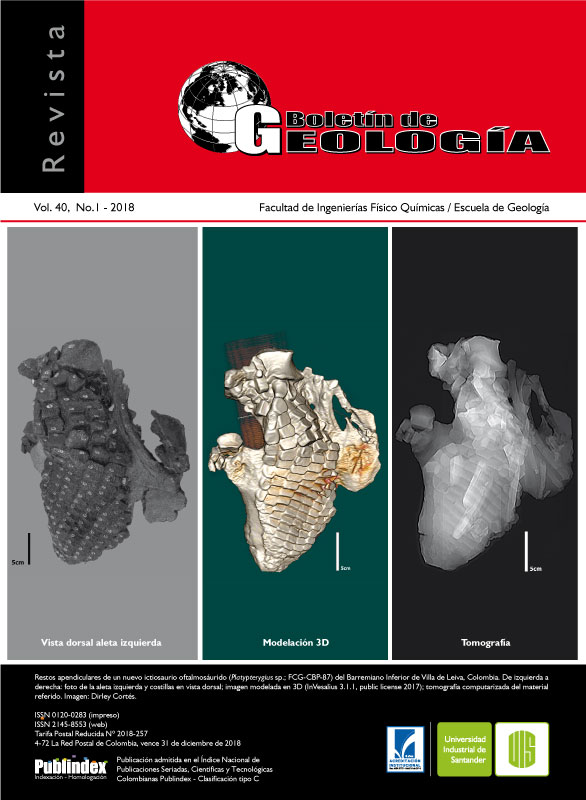Possibilities for CO2 capture and storage (CCS) in Colombia - case Tauramena (Casanare)
Published 2018-02-23
Keywords
- Carbon capture and storage,
- CCS,
- CO2 sequestration,
- Carbonera formation,
- geological storage
How to Cite
Altmetrics
Abstract
The anthropogenic climate effects can be mitigated through various measures, including the capture of CO2 in geologic structures (CCS). Geological structures for sequestration of CO2 do not really need any important technological development, because the technology has been developed and applied by the energy industry for hydrocarbons exploration and production. The challenge is rather to identify the best methods and sites to capture CO2 for long term storage. There are some ways for CO2 storage in geological media, among them: use in EOR operations, elimination in depleted reservoirs of oil and gas, storage in layers where the coal bed methane (CBM) has been desorbed, injection in deep saline aquifers and storage in salt caverns that have been exploited. There are several criteria to consider when evaluating the potential of a sedimentary basin of storage of CO2: its tectonic and geological setting, the geothermal regime in the basin, the hydrodynamic flow regime, the potential for hydrocarbons and maturity of basin, economic aspects related to access, infrastructure, and socio-political conditions. The conditions for the implementation of the method of storage of CO2 in the Llanos basin (Tauramena, Casanare) are favorable due
to the presence of several members of the Carbonera formation with good thickness and permeability; additionally, the presence of the overlaying regional seal of the León formation, and the development of technologies in the hydrocarbon industry, favoring the selection of this basin for potential pilot projects and subsequent commercial implementation of the CCS method in the basin.
Downloads
References
Bachu, S. (2000). Sequestration of CO2 in geological media: criteria and approach for site selection in response to climate change. Energy Conversion and Management, 41(9), 953-970. doi: 10.1016/S0196-8904(99)00149-1.
Bennaceur, K., Gielen, D., Kerr, T., and Tam, C. (2008). CO2 capture and storage: A key carbon abatement option. IEA/OECD: Paris.
Bennaceur, K., Gupta, N., Monea, M., Ramakrishnan, T., Randen, T., Sakurai, S., y Whittaker, S. (2004). Captación y almacenamiento de CO2: Una solución al alcance de la mano. Oilfield Review, 16(4), 48-65.
Cámara, A. Navarrete, B., Candil, R., Vilanova, E., Segarra, J., Morán, S., Zapatero, M., Gómez, M., Peña, F., García, A., Gil, J., Pina, J., Chamberlain, J., Martínez, R., Arenillas, A., Cortina, V., Valle, L., Penelas, G., Menéndez, E., Loredo, J., y Llamas, B. (2010). Captura y almacenamiento de CO2. X Congreso Nacional del Medio Ambiente, CONAMA 10, CIEMAT, Madrid.
Consoli, C., Havercroft, I., and Irlan, L. (2017). Carbon capture and storage readiness index: comparative review of global progress towards wide-scale deployment. Energy Procedia, 114, 7348-7355. doi: 10.1016/j.egypro.2017.03.1585.
Consoli, C., and Wildgust, N. (2017). Current status of global storage resources. Energy Procedia, 114, 4623-4628. doi: 10.1016/j.egypro.2017.03.1866.
Cooper, M., Addison, F., Alvarez, R., Coral, M., Graham, R., Hayward, A., Howe, S., Martinez, J., Naar, J., Peñas, R., Pulham, A.J., and Taborda, A. (1995). Basin development and tectonic history of the Llanos Basin, Eastern Cordillera, and Middle Magdalena Valley, Colombia. A.A.P.G Bulletin, 79(10), 1421-1443.
Couëslan, M.L., Ali, S., Campbell, A., Nutt, W.L., Leaney, W.S., Finley, R.J., and Greenberg, S. (2013). Monitoring CO2 injection for carbon capture and storage using time-lapse 3D VSPs. The Leading Edge, 32(10), 1268-1276. doi: 10.1190/tle32101268.1.
ECOPETROL. (2014). Taller de pozos de inyección. Conferencia N° 1. Bogotá.
GEOPARK. (2014). Plan de manejo ambiental para la perforación exploratoria en la locación multipozos Tigana Sur.
Holloway, S., Chadwick, A., Lindeberg, E., Czernichowski-Lauriol, I., and Arts, B. (2003). Practice manual from SACS-Saline Aquifer CO2 Storage project. IEA Greenhouse Gas R&D Programme, Statoil Research Center: Trondheim, Norway.
Hurtado, A. (2010). Metodología para la estimación regional de la capacidad de almacenamiento de CO2 en formaciones permeables profundas y sus incertidumbres. Tesis Doctoral. Universidad de León, España.
Koperna, G., Riestenberg, D., Kuuskraa, V., Rhudy, R., Trautz, R., Hill, G.R., and Esposito, R. (2012). The SECARB anthropogenic test: a US integrated CO2, capture, transportation and storage test. International Journal of Clean Coal and Energy, 1(2), 13-26. doi: 10.4236/ijcce.2012.12002.
Mendoza J., y Bueno J. (2008). Modelado de causas geológicas generadoras de sobrepresión. Aplicación para la formación Carbonera en el campo Cupiagua del Piedemonte Llanero Colombiano. Tesis. Escuela de Geología, Universidad Industrial de Santander, Bucaramanga, Colombia.
Metz, B., Davidson, O., de Coninck, H., Loos, M., and Meyer, L. (2006). Special report on carbon dioxide capture and storage. Cambridge University Press: Cambridge, U.K.
Morales, H., y Torres, C. (2008). Tecnologías de captura y secuestro de CO2. Escuela de Ingeniería, Pontificia Universidad Católica de Chile, Santiago de Chile, Chile.
PAREX. (2014). Estudio de impacto ambiental Bloque Llanos 40. Parex Resources Colombia LTD Sucursal.
Warwick, P. (2016). Overview of USGS carbon sequestration – geologic research and assessments project. The National Academies of Sciences, Engineering, and Medicine. Consultado el 18 de septiembre de 2017. http://dels.nas.edu/resources/static-assets/basc/miscellaneous/cdr-mtg-1/warwick.pdf.

